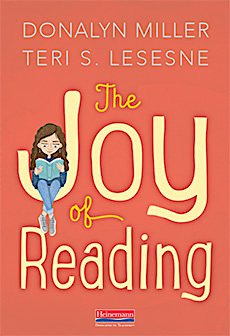The Joy of Sharing Our Love of Reading
The Joy of Reading
By Donalyn Miller and Teri Lesesne
(Heinemann, 2022 – Learn more)
Reviewed by Cathy Gassenheimer

He added, “I want to be a librarian because books can take me to places I’ve never been before and may never visit. It opens the door to new ideas. When I read, I feel smarter.”
The audience, made up of business and civic executives, then had a chance to ask the students questions. One person stood up and posed this question to our future librarian. “So, what might you want to be instead of librarian?” From her question, I inferred that she didn’t think being a librarian was “good enough.”
The student looked her squarely in the eye and said, “I only want to be a librarian. That way, I can help other students learn to love reading like I do.”
The rest of the audience applauded.
Sharing the joy and love of reading

In this book both share their love of reading and strategies to create more lifelong readers (and librarians) like the student described above. They provide ready-to-implement strategies to help you over time convert your reluctant readers into avid readers.
Sadly, too few students these days love to read. In addition to the many activities competing for their time – video games, sports, social media, and streaming videos – many students told the authors “they find little value for reading outside of school or work or even that they hate reading” (p. xvi). This book attempts to serve as an antidote? to that apathy or dislike. As the authors note: “It is possible to teach children how to read well without killing their love for reading in the process” (p. xvii).
The authors practice what they preach. They are avid readers and Miller constantly adds to her list of books that might appeal to adolescents and younger readers. They used their years of teaching and reading to create a very inviting and user-friend book: Even the cover entices the reader to open it and begin reading!
What you’ll find inside
This book is manna for those of us who love reading and can’t imagine not having a book at hand (or listening to one). And it is a must-have tool for educators who teach students how to read or work to expand their comprehension and affinity for books and stories.
The annotated table of contents provides readers with a quick summary of the book, making it easy to turn to a specific section to find just-in-time strategies to help spur your students’ love of reading. Just reading the titles of the chapters will likely make you smile:
Chapter 1: Joy: What Is It Good For?
Chapter 2: Joyful Reading Relies on Abundant Access and Time
Chapter 3: Joyful Reading Encourages Reader’s Choices
Chapter 4: Joyful Reading Honors Readers’ Responses
Chapter 5: Joyful Reading Thrives in a Supportive Community
The book also offers five appendices with resources ranging from book lists to student surveys.
Creating Lovers of Books
Throughout the book the authors provide valuable tips about how to create life-long readers. It begins with spending individual time with each student to learn more about their interests and hobbies.
Choice is an important part of creating joyful readers. Online surveys, classroom surveys, and short individual chats with students can help surface the genres or specific topics of interest to students. Sharing specific books with students that you think they might like is a good first start, with a willingness to keep searching if the student isn’t interested.
A simple survey might ask students the following questions:
- What is the best book you ever read?
- When and where do you like to read?
- What are your interests and hobbies?
- What are your responsibilities after school?
- What do you wish I knew about you and your interests? (p. 98)
The authors share an example of an online student reading survey here.
The authors suggest teachers be prepared to help reluctant readers or those that express “vague or limited preferences.” Helping them preview different types of books or pairing them with a more avid reader for a short book talk might help.
Book Talks
If the concept of book talks is new to you, the authors provide the following tips:
- Keep it short! Good book talks can be as short as 2-3 minutes.
- Identify a few enticing key points.
- Think about hooks: Read a short excerpt? Show an engaging illustration? Read one of the poems (if it is a poetry collection)? Pose an engaging question that might draw the reader to the book.
- Focus on books that address the topics/interests identified by your students.
- Ensure you have a process for handling a situation where multiple students want to read the same book. The authors suggest drawing names from a cup, keeping a reserve list, or checking with a nearby public library for availability.
This link will take you to a book talk that is short, concise, and actually explains how to create a book talk, all in less that 2 minutes!
You should also check out the Nerdy Book Club, co-founded by Donalyn Miller, featuring summaries of book talks. Here’s a link to the “Top Ten Book Talks I Make Every Year,” by a middle school teacher Julie Demicco.
It Starts with You
Avid readers encourage others to read. Making reading a part of your everyday routine is important. Read both books that you think your students will enjoy AND books that you enjoy. And, if the book doesn’t catch your fancy, put it down and choose another. There are plenty of books just waiting for you to pick up!
Your Reading Autobiography
One way to assess your reading history is to create a reading autobiography. Miller and Lesesne suggest that you think about the books that you loved or that influenced your thinking over the years. Once you’ve thought about those books, jot down a list of ten books that, for now, stand out for you. To help you get started, they suggest the following reflection questions:
- What is the first book you remember reading?
- What read-alouds do you remember? At home? At school?
- What books from your childhood or teen years do you remember reading?
- What was the first book you read where you connected with the protagonist or subject?
- What books have shaped your worldview or life choices?
- What books have you shared with other readers?
- Do you have traditions or rituals connected with specific books?
I liked this idea so much that at one of our adult book clubs, everyone created their own reading autobiography. As each person shared, we heard oohs and aahs from others, often wanting to add that book to their list. We agreed to revisit this process every year or so, knowing that our list would change and grow!
So Much More
There is so much more to Miller and Lesesne’s valuable book than I’ve captured in this short review. As I think back to our future librarian, I feel sure that his teachers used many of these strategies to nurture his love of reading. But it wasn’t just the teachers. The principal regularly visited classrooms and spoke to students about the books they were reading. Students were reading in the hallway as they waited for restroom breaks or lunch. And the school had a very lenient lending policy for library books.
When I think about joy, I think about many things. Family, friends, health – and books! Just like our future librarian, books open my mind, take me to new places, and restore my soul. What a gift to give to students, something that can last a lifetime!
Read another review of The Joy of Reading
Cathy Gassenheimer is a professional learning consultant specializing in collaborative adult learning and collective efficacy. For 22 years she was Executive Vice President of the Alabama Best Practices Center, a program of Alabama’s statewide business/community nonprofit A+ Education Partnership, and led the work of three statewide educator networks focused on teaching, leadership, and instructional coaching. Connect with her via LinkedIn and on Twitter @cathygassenheim.






























